University Hydro-Electric Power Generation Report: System Engineering
VerifiedAdded on 2022/09/14
|15
|2967
|16
Report
AI Summary
This report provides a comprehensive analysis of hydro-electric power generation, focusing on the stakeholder needs, conceptual design process, and system requirements for a project in Australia. The report begins with an introduction to hydro-electric energy and its importance as a renewable resource, followed by an examination of stakeholder needs, categorized as primary and secondary, including investors, government institutions, local communities, and the general public. The conceptual design process is then explored, including plant architecture, feasibility studies, and the selection of plant size and site. The report also discusses operating rules, capacity and power generation calculations, plant location considerations, and grid connection points. Constraints, such as geological conditions and environmental factors, are identified, along with system requirements encompassing dams, pipelines, turbines, generators, transformers, power lines, and outflow systems. The report concludes by summarizing the key findings and emphasizing the importance of stakeholder involvement and environmental considerations in the design and implementation of hydro-electric power projects.
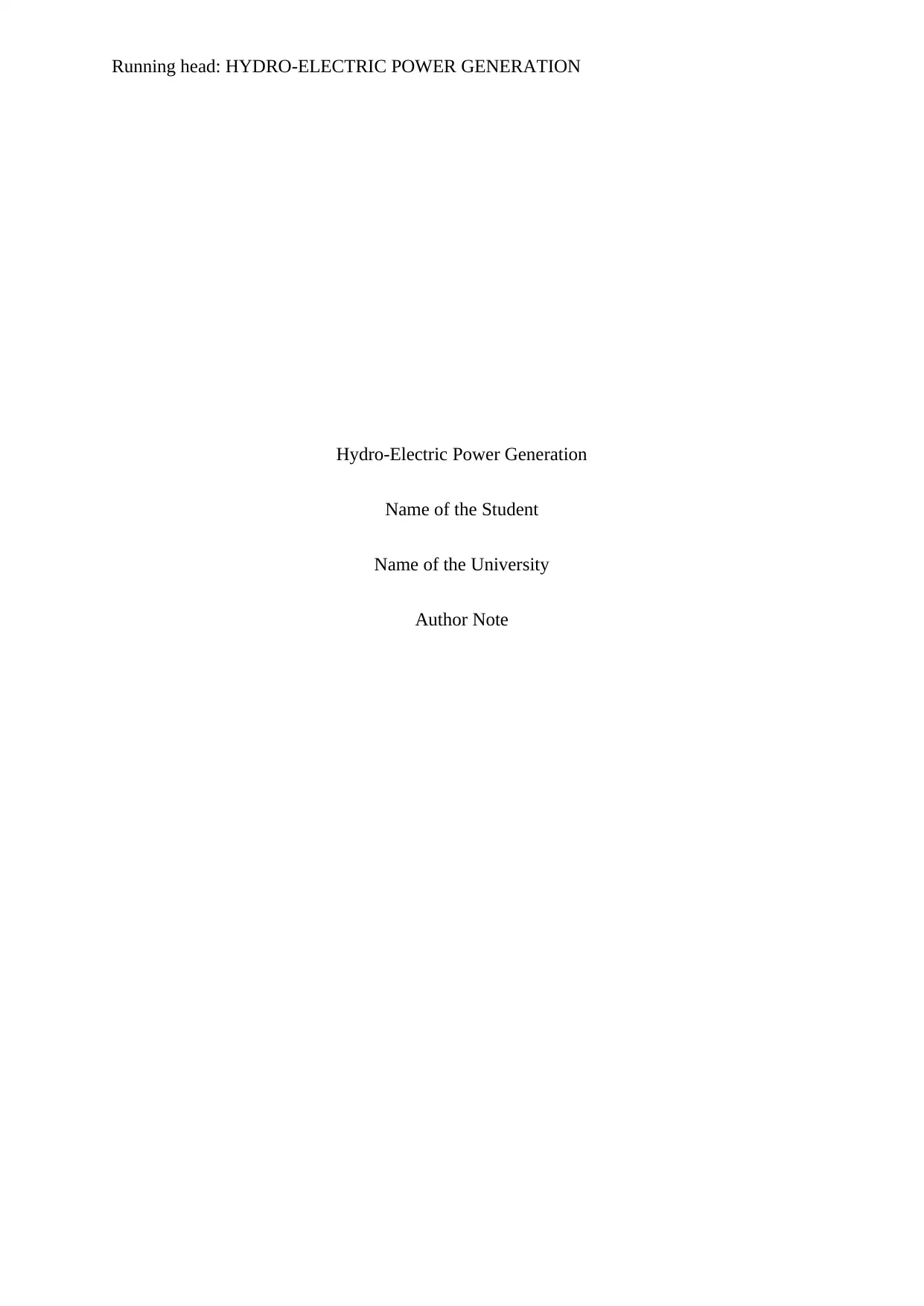
Running head: HYDRO-ELECTRIC POWER GENERATION
Hydro-Electric Power Generation
Name of the Student
Name of the University
Author Note
Hydro-Electric Power Generation
Name of the Student
Name of the University
Author Note
Paraphrase This Document
Need a fresh take? Get an instant paraphrase of this document with our AI Paraphraser
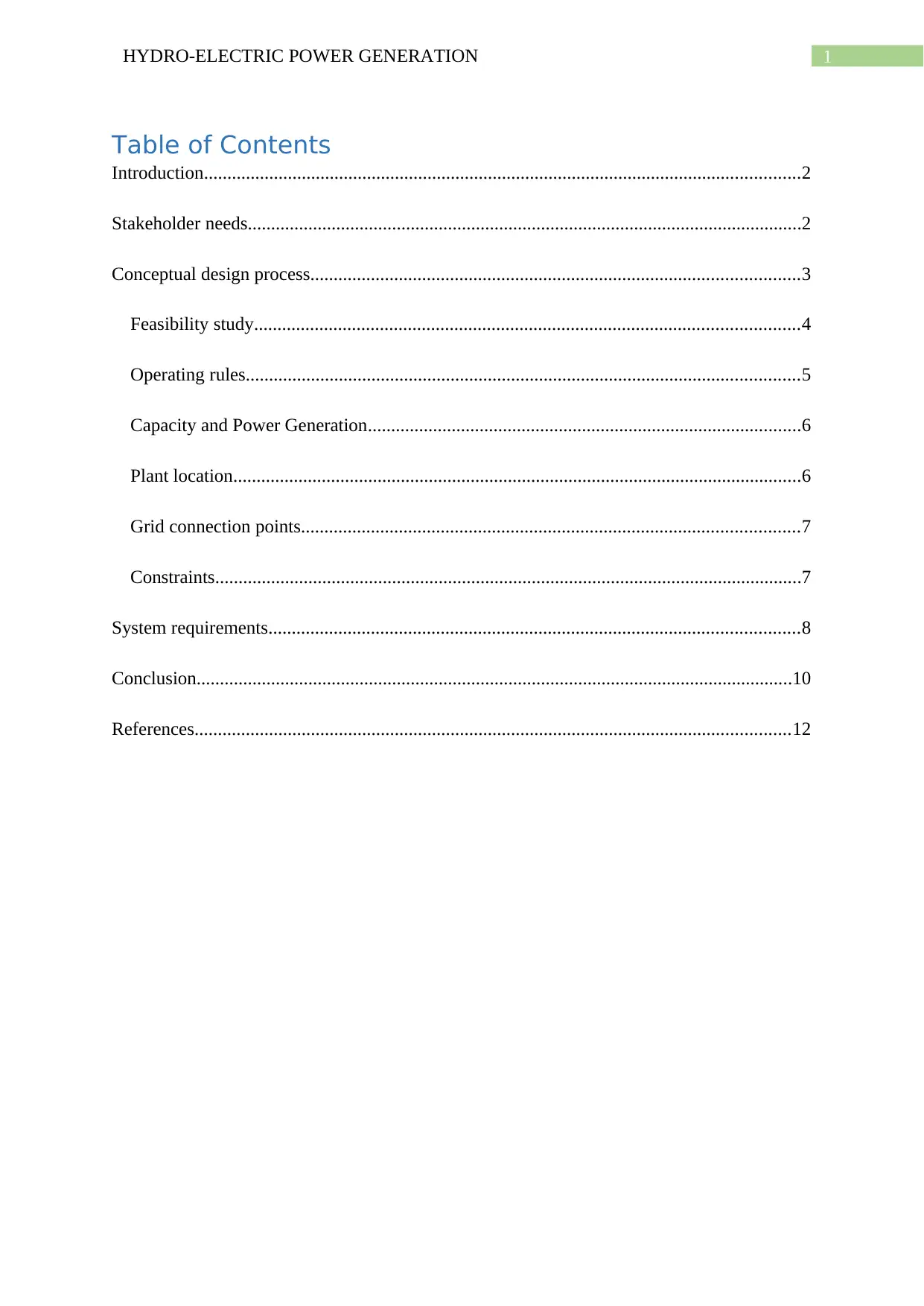
1HYDRO-ELECTRIC POWER GENERATION
Table of Contents
Introduction................................................................................................................................2
Stakeholder needs.......................................................................................................................2
Conceptual design process.........................................................................................................3
Feasibility study.....................................................................................................................4
Operating rules.......................................................................................................................5
Capacity and Power Generation.............................................................................................6
Plant location..........................................................................................................................6
Grid connection points...........................................................................................................7
Constraints..............................................................................................................................7
System requirements..................................................................................................................8
Conclusion................................................................................................................................10
References................................................................................................................................12
Table of Contents
Introduction................................................................................................................................2
Stakeholder needs.......................................................................................................................2
Conceptual design process.........................................................................................................3
Feasibility study.....................................................................................................................4
Operating rules.......................................................................................................................5
Capacity and Power Generation.............................................................................................6
Plant location..........................................................................................................................6
Grid connection points...........................................................................................................7
Constraints..............................................................................................................................7
System requirements..................................................................................................................8
Conclusion................................................................................................................................10
References................................................................................................................................12

2HYDRO-ELECTRIC POWER GENERATION
Introduction
Hydro-electric energy is a most common source of renewable energy. The electric
energy is generated by using the flow of circulating water. The water dropping from a high
point to low point creates a potential that is converted to the electrical energy through the
water turbine (Wood, Wollenberg & Sheblé, 2013). The energy generation from hydro
turbines are highly scalable according with the systems and helps in meeting the requirements
for villages and up to national level of energy needs. Renewable energy resources can expand
the country’s electricity access on a reliable and affordable cost. The designs of hydro-power
have seen with more often flexibilities in terms of goals. This report intends to discuss the
stakeholder needs for developing a Hydro-electric power project in Australia and its
requirements analysis. A case study of Entura which is consultancy in field of renewable
energy and water, has been observed. It has a best history of development in energy projects
in Australia (csiro.au, 2018). It has been working with the Australian government and
stakeholders mainly in the northern parts. The main demand of this project is for electricity
supplies and irrigation. The main objectives and aim of the report is to identify the
requirements to develop a hydro-project according to the stakeholder needs. In the later
sections, the conceptual designs for implementation and its outputs are also achieved.
Stakeholder needs
Stakeholder needs is the base of the hydro-electric power generation or any other
renewable power generation. Government can be said to be main supporting actor in the field
of energy. Stating Government as a helper defines the major stakeholders of the project are
the publics (Rosso et al., 2014). Public thinks that the renewable energy sources are free and
commonly available (mainly solar energy) in Australia. Hence it is clear that public
investments in these type of research and development are being used for tacking the
Introduction
Hydro-electric energy is a most common source of renewable energy. The electric
energy is generated by using the flow of circulating water. The water dropping from a high
point to low point creates a potential that is converted to the electrical energy through the
water turbine (Wood, Wollenberg & Sheblé, 2013). The energy generation from hydro
turbines are highly scalable according with the systems and helps in meeting the requirements
for villages and up to national level of energy needs. Renewable energy resources can expand
the country’s electricity access on a reliable and affordable cost. The designs of hydro-power
have seen with more often flexibilities in terms of goals. This report intends to discuss the
stakeholder needs for developing a Hydro-electric power project in Australia and its
requirements analysis. A case study of Entura which is consultancy in field of renewable
energy and water, has been observed. It has a best history of development in energy projects
in Australia (csiro.au, 2018). It has been working with the Australian government and
stakeholders mainly in the northern parts. The main demand of this project is for electricity
supplies and irrigation. The main objectives and aim of the report is to identify the
requirements to develop a hydro-project according to the stakeholder needs. In the later
sections, the conceptual designs for implementation and its outputs are also achieved.
Stakeholder needs
Stakeholder needs is the base of the hydro-electric power generation or any other
renewable power generation. Government can be said to be main supporting actor in the field
of energy. Stating Government as a helper defines the major stakeholders of the project are
the publics (Rosso et al., 2014). Public thinks that the renewable energy sources are free and
commonly available (mainly solar energy) in Australia. Hence it is clear that public
investments in these type of research and development are being used for tacking the
⊘ This is a preview!⊘
Do you want full access?
Subscribe today to unlock all pages.

Trusted by 1+ million students worldwide
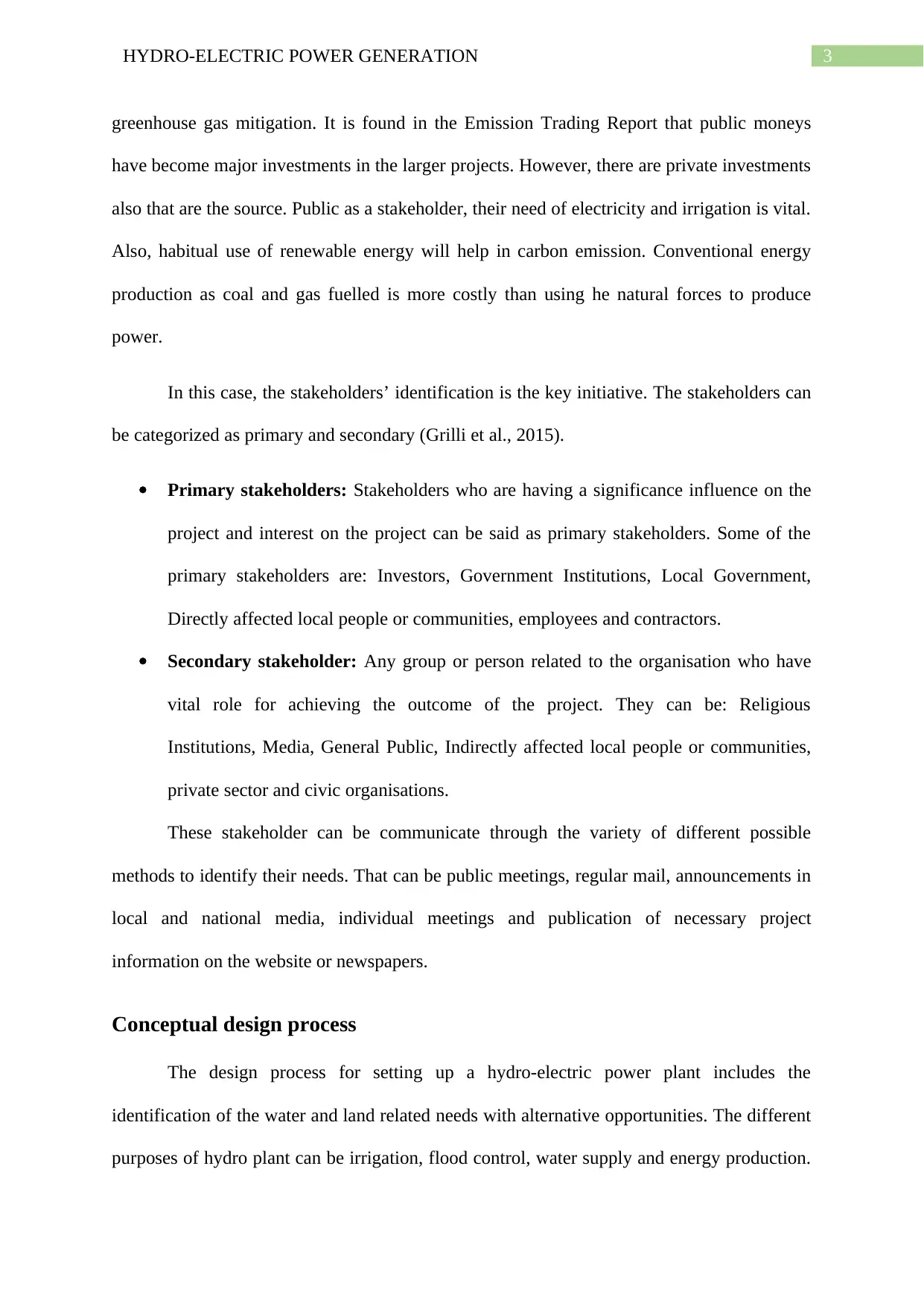
3HYDRO-ELECTRIC POWER GENERATION
greenhouse gas mitigation. It is found in the Emission Trading Report that public moneys
have become major investments in the larger projects. However, there are private investments
also that are the source. Public as a stakeholder, their need of electricity and irrigation is vital.
Also, habitual use of renewable energy will help in carbon emission. Conventional energy
production as coal and gas fuelled is more costly than using he natural forces to produce
power.
In this case, the stakeholders’ identification is the key initiative. The stakeholders can
be categorized as primary and secondary (Grilli et al., 2015).
Primary stakeholders: Stakeholders who are having a significance influence on the
project and interest on the project can be said as primary stakeholders. Some of the
primary stakeholders are: Investors, Government Institutions, Local Government,
Directly affected local people or communities, employees and contractors.
Secondary stakeholder: Any group or person related to the organisation who have
vital role for achieving the outcome of the project. They can be: Religious
Institutions, Media, General Public, Indirectly affected local people or communities,
private sector and civic organisations.
These stakeholder can be communicate through the variety of different possible
methods to identify their needs. That can be public meetings, regular mail, announcements in
local and national media, individual meetings and publication of necessary project
information on the website or newspapers.
Conceptual design process
The design process for setting up a hydro-electric power plant includes the
identification of the water and land related needs with alternative opportunities. The different
purposes of hydro plant can be irrigation, flood control, water supply and energy production.
greenhouse gas mitigation. It is found in the Emission Trading Report that public moneys
have become major investments in the larger projects. However, there are private investments
also that are the source. Public as a stakeholder, their need of electricity and irrigation is vital.
Also, habitual use of renewable energy will help in carbon emission. Conventional energy
production as coal and gas fuelled is more costly than using he natural forces to produce
power.
In this case, the stakeholders’ identification is the key initiative. The stakeholders can
be categorized as primary and secondary (Grilli et al., 2015).
Primary stakeholders: Stakeholders who are having a significance influence on the
project and interest on the project can be said as primary stakeholders. Some of the
primary stakeholders are: Investors, Government Institutions, Local Government,
Directly affected local people or communities, employees and contractors.
Secondary stakeholder: Any group or person related to the organisation who have
vital role for achieving the outcome of the project. They can be: Religious
Institutions, Media, General Public, Indirectly affected local people or communities,
private sector and civic organisations.
These stakeholder can be communicate through the variety of different possible
methods to identify their needs. That can be public meetings, regular mail, announcements in
local and national media, individual meetings and publication of necessary project
information on the website or newspapers.
Conceptual design process
The design process for setting up a hydro-electric power plant includes the
identification of the water and land related needs with alternative opportunities. The different
purposes of hydro plant can be irrigation, flood control, water supply and energy production.
Paraphrase This Document
Need a fresh take? Get an instant paraphrase of this document with our AI Paraphraser

4HYDRO-ELECTRIC POWER GENERATION
Australia have their hydropower schemes categorized according to the capacity. Production
of less than 1 Mega Watt power is called micro hydro, between 1-30 Mega Watt is called
mini hydro and production above that is called large hydro (Bahadori, Zahedi &
Zendehboudi, 2013). The main focus of the design process should be initially to select the
plant size and the site.
Figure 1: Power Plant Architecture
For establishing multi-purpose plants require following planning and design phases:
Feasibility study
The feasibility study will deal with the optimization of all the parameters and layout
of the plant. This phase includes the drawings and report preparation for determining the
plant’s dimension. System engineering, economic market, preliminary design, environmental
conditions and hydrologic will be used to evaluate the alternatives (Adhikary, Roy &
Mazumdar, 2014). Following alternatives can be examined and considered for selection:
i. Alternative purposes.
ii. Alternative locations.
iii. Alternative configurations.
Australia have their hydropower schemes categorized according to the capacity. Production
of less than 1 Mega Watt power is called micro hydro, between 1-30 Mega Watt is called
mini hydro and production above that is called large hydro (Bahadori, Zahedi &
Zendehboudi, 2013). The main focus of the design process should be initially to select the
plant size and the site.
Figure 1: Power Plant Architecture
For establishing multi-purpose plants require following planning and design phases:
Feasibility study
The feasibility study will deal with the optimization of all the parameters and layout
of the plant. This phase includes the drawings and report preparation for determining the
plant’s dimension. System engineering, economic market, preliminary design, environmental
conditions and hydrologic will be used to evaluate the alternatives (Adhikary, Roy &
Mazumdar, 2014). Following alternatives can be examined and considered for selection:
i. Alternative purposes.
ii. Alternative locations.
iii. Alternative configurations.
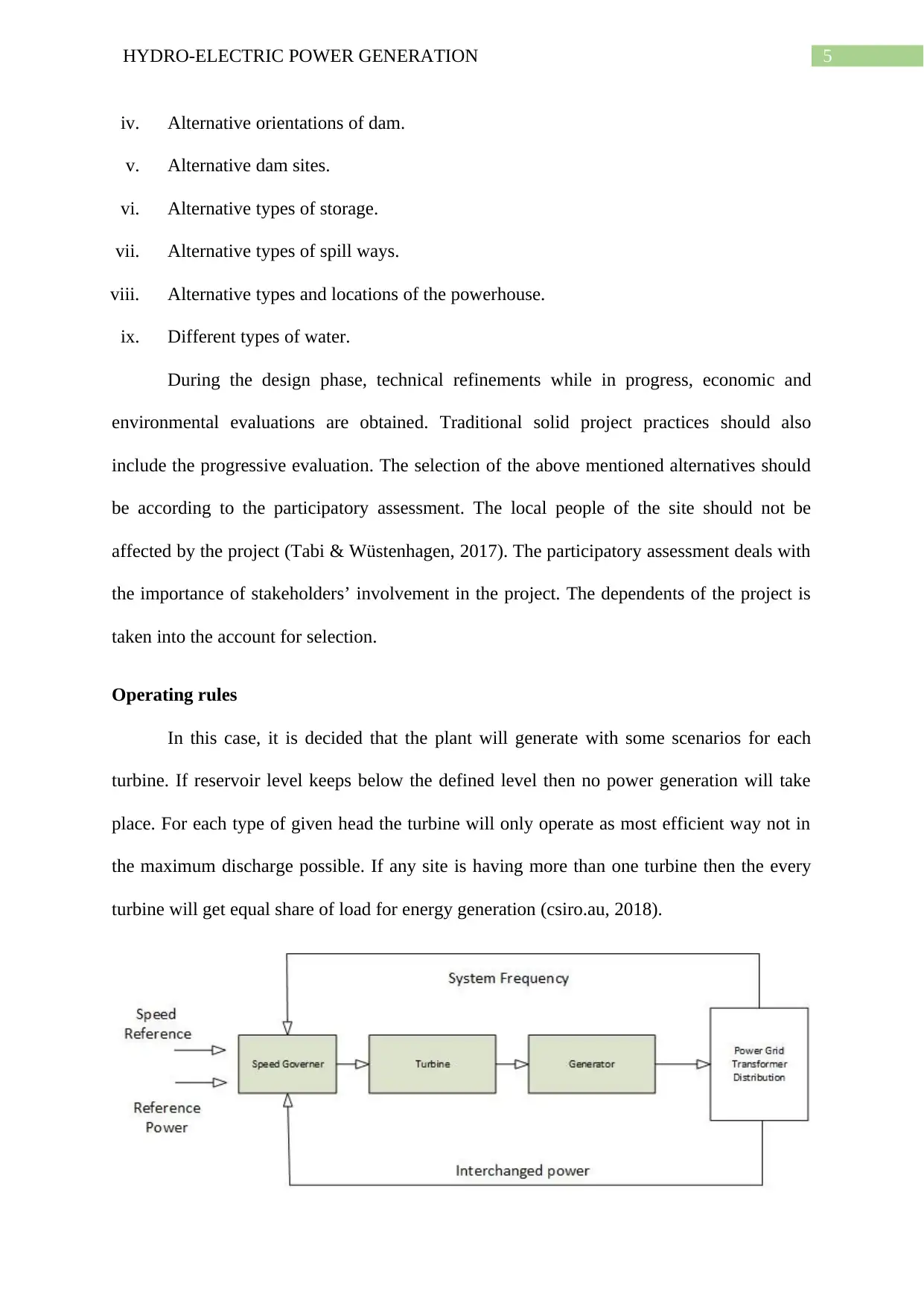
5HYDRO-ELECTRIC POWER GENERATION
iv. Alternative orientations of dam.
v. Alternative dam sites.
vi. Alternative types of storage.
vii. Alternative types of spill ways.
viii. Alternative types and locations of the powerhouse.
ix. Different types of water.
During the design phase, technical refinements while in progress, economic and
environmental evaluations are obtained. Traditional solid project practices should also
include the progressive evaluation. The selection of the above mentioned alternatives should
be according to the participatory assessment. The local people of the site should not be
affected by the project (Tabi & Wüstenhagen, 2017). The participatory assessment deals with
the importance of stakeholders’ involvement in the project. The dependents of the project is
taken into the account for selection.
Operating rules
In this case, it is decided that the plant will generate with some scenarios for each
turbine. If reservoir level keeps below the defined level then no power generation will take
place. For each type of given head the turbine will only operate as most efficient way not in
the maximum discharge possible. If any site is having more than one turbine then the every
turbine will get equal share of load for energy generation (csiro.au, 2018).
iv. Alternative orientations of dam.
v. Alternative dam sites.
vi. Alternative types of storage.
vii. Alternative types of spill ways.
viii. Alternative types and locations of the powerhouse.
ix. Different types of water.
During the design phase, technical refinements while in progress, economic and
environmental evaluations are obtained. Traditional solid project practices should also
include the progressive evaluation. The selection of the above mentioned alternatives should
be according to the participatory assessment. The local people of the site should not be
affected by the project (Tabi & Wüstenhagen, 2017). The participatory assessment deals with
the importance of stakeholders’ involvement in the project. The dependents of the project is
taken into the account for selection.
Operating rules
In this case, it is decided that the plant will generate with some scenarios for each
turbine. If reservoir level keeps below the defined level then no power generation will take
place. For each type of given head the turbine will only operate as most efficient way not in
the maximum discharge possible. If any site is having more than one turbine then the every
turbine will get equal share of load for energy generation (csiro.au, 2018).
⊘ This is a preview!⊘
Do you want full access?
Subscribe today to unlock all pages.

Trusted by 1+ million students worldwide

6HYDRO-ELECTRIC POWER GENERATION
Figure 2: Functional Block Diagram
Source: created by author
Capacity and Power Generation
The total capacity can be calculated by the sum of the rated capacity of all the units in
plant. These rated capacities are supposed to provide at a decided head, efficiency and
discharge. Sometimes the total installed capacity is also known as the nominal capacity
(Engevik, Valavi & Nysveen, 2016).
The nominal capacity is calculated by the power equation:
P = 𝜌 ∙ 𝑔 ∙ 𝜂 ∙ 𝑄𝑑 ∙ 𝐻𝑛
Here,
P = all unit’s power output (W).
𝜌 = density of water (kg/m3).
𝑔 = gravity, (m/s2).
𝜂 = overall efficiency of turbines, generator, transformer.
𝑄𝑑 = discharge of power plant, (m3/s).
𝐻𝑛 = net head, (m).
Plant location
Multiple site may be selected to generate power as a network. Northern Australia have
multiple environment places for the plant establishment where the flow of water discharge is
different (Lu et al., 2018). A financial evaluation is required to set up plant on multiple sites.
The available sites are Mt Bennett, Upper Adelaide, Mitchell and Elizabeth. Mt bennet has
Figure 2: Functional Block Diagram
Source: created by author
Capacity and Power Generation
The total capacity can be calculated by the sum of the rated capacity of all the units in
plant. These rated capacities are supposed to provide at a decided head, efficiency and
discharge. Sometimes the total installed capacity is also known as the nominal capacity
(Engevik, Valavi & Nysveen, 2016).
The nominal capacity is calculated by the power equation:
P = 𝜌 ∙ 𝑔 ∙ 𝜂 ∙ 𝑄𝑑 ∙ 𝐻𝑛
Here,
P = all unit’s power output (W).
𝜌 = density of water (kg/m3).
𝑔 = gravity, (m/s2).
𝜂 = overall efficiency of turbines, generator, transformer.
𝑄𝑑 = discharge of power plant, (m3/s).
𝐻𝑛 = net head, (m).
Plant location
Multiple site may be selected to generate power as a network. Northern Australia have
multiple environment places for the plant establishment where the flow of water discharge is
different (Lu et al., 2018). A financial evaluation is required to set up plant on multiple sites.
The available sites are Mt Bennett, Upper Adelaide, Mitchell and Elizabeth. Mt bennet has
Paraphrase This Document
Need a fresh take? Get an instant paraphrase of this document with our AI Paraphraser
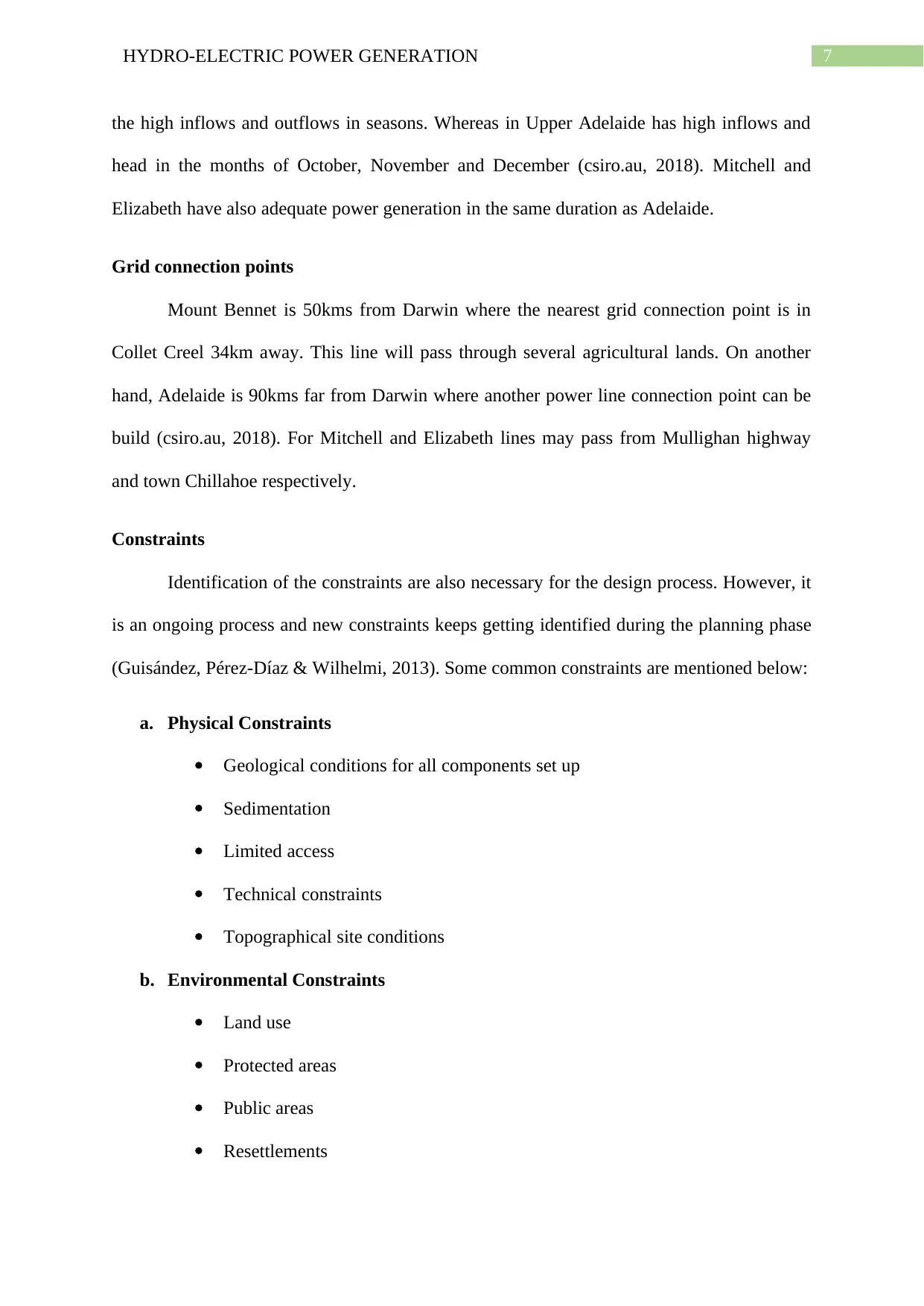
7HYDRO-ELECTRIC POWER GENERATION
the high inflows and outflows in seasons. Whereas in Upper Adelaide has high inflows and
head in the months of October, November and December (csiro.au, 2018). Mitchell and
Elizabeth have also adequate power generation in the same duration as Adelaide.
Grid connection points
Mount Bennet is 50kms from Darwin where the nearest grid connection point is in
Collet Creel 34km away. This line will pass through several agricultural lands. On another
hand, Adelaide is 90kms far from Darwin where another power line connection point can be
build (csiro.au, 2018). For Mitchell and Elizabeth lines may pass from Mullighan highway
and town Chillahoe respectively.
Constraints
Identification of the constraints are also necessary for the design process. However, it
is an ongoing process and new constraints keeps getting identified during the planning phase
(Guisández, Pérez-Díaz & Wilhelmi, 2013). Some common constraints are mentioned below:
a. Physical Constraints
Geological conditions for all components set up
Sedimentation
Limited access
Technical constraints
Topographical site conditions
b. Environmental Constraints
Land use
Protected areas
Public areas
Resettlements
the high inflows and outflows in seasons. Whereas in Upper Adelaide has high inflows and
head in the months of October, November and December (csiro.au, 2018). Mitchell and
Elizabeth have also adequate power generation in the same duration as Adelaide.
Grid connection points
Mount Bennet is 50kms from Darwin where the nearest grid connection point is in
Collet Creel 34km away. This line will pass through several agricultural lands. On another
hand, Adelaide is 90kms far from Darwin where another power line connection point can be
build (csiro.au, 2018). For Mitchell and Elizabeth lines may pass from Mullighan highway
and town Chillahoe respectively.
Constraints
Identification of the constraints are also necessary for the design process. However, it
is an ongoing process and new constraints keeps getting identified during the planning phase
(Guisández, Pérez-Díaz & Wilhelmi, 2013). Some common constraints are mentioned below:
a. Physical Constraints
Geological conditions for all components set up
Sedimentation
Limited access
Technical constraints
Topographical site conditions
b. Environmental Constraints
Land use
Protected areas
Public areas
Resettlements

8HYDRO-ELECTRIC POWER GENERATION
Cultural heritages
Fish migration in the river
c. External Constraints
Minimum discharge requirements(river rafting, tourism and natural flow)
Schedule of storage release for downstream use (irrigation, water supply,
navigational requirements).
Flood control.
Minimum storage requirements (tourism, navigation, irrigation on upper parts
etc.)
Maximum discharge limits to reduce the risk of soil erosion.
Hydro peaking limitation.
System requirements
Hydropower generation is usually done by transforming the potential energy of water
mass into a streamline of water (kinetic energy) (Sipahutar, Bernas & Imanuddin, 2013). The
average power generation is totally depends on the head and flow of the water. The
streamline then helps to move the turbine which produces the mechanical energy. The turbine
drives the generator and electricity is produced (Xu et al., 2015). The system requirements for
a full working hydro-electro plant needs the various components and design of the water
flow.
Cultural heritages
Fish migration in the river
c. External Constraints
Minimum discharge requirements(river rafting, tourism and natural flow)
Schedule of storage release for downstream use (irrigation, water supply,
navigational requirements).
Flood control.
Minimum storage requirements (tourism, navigation, irrigation on upper parts
etc.)
Maximum discharge limits to reduce the risk of soil erosion.
Hydro peaking limitation.
System requirements
Hydropower generation is usually done by transforming the potential energy of water
mass into a streamline of water (kinetic energy) (Sipahutar, Bernas & Imanuddin, 2013). The
average power generation is totally depends on the head and flow of the water. The
streamline then helps to move the turbine which produces the mechanical energy. The turbine
drives the generator and electricity is produced (Xu et al., 2015). The system requirements for
a full working hydro-electro plant needs the various components and design of the water
flow.
⊘ This is a preview!⊘
Do you want full access?
Subscribe today to unlock all pages.

Trusted by 1+ million students worldwide
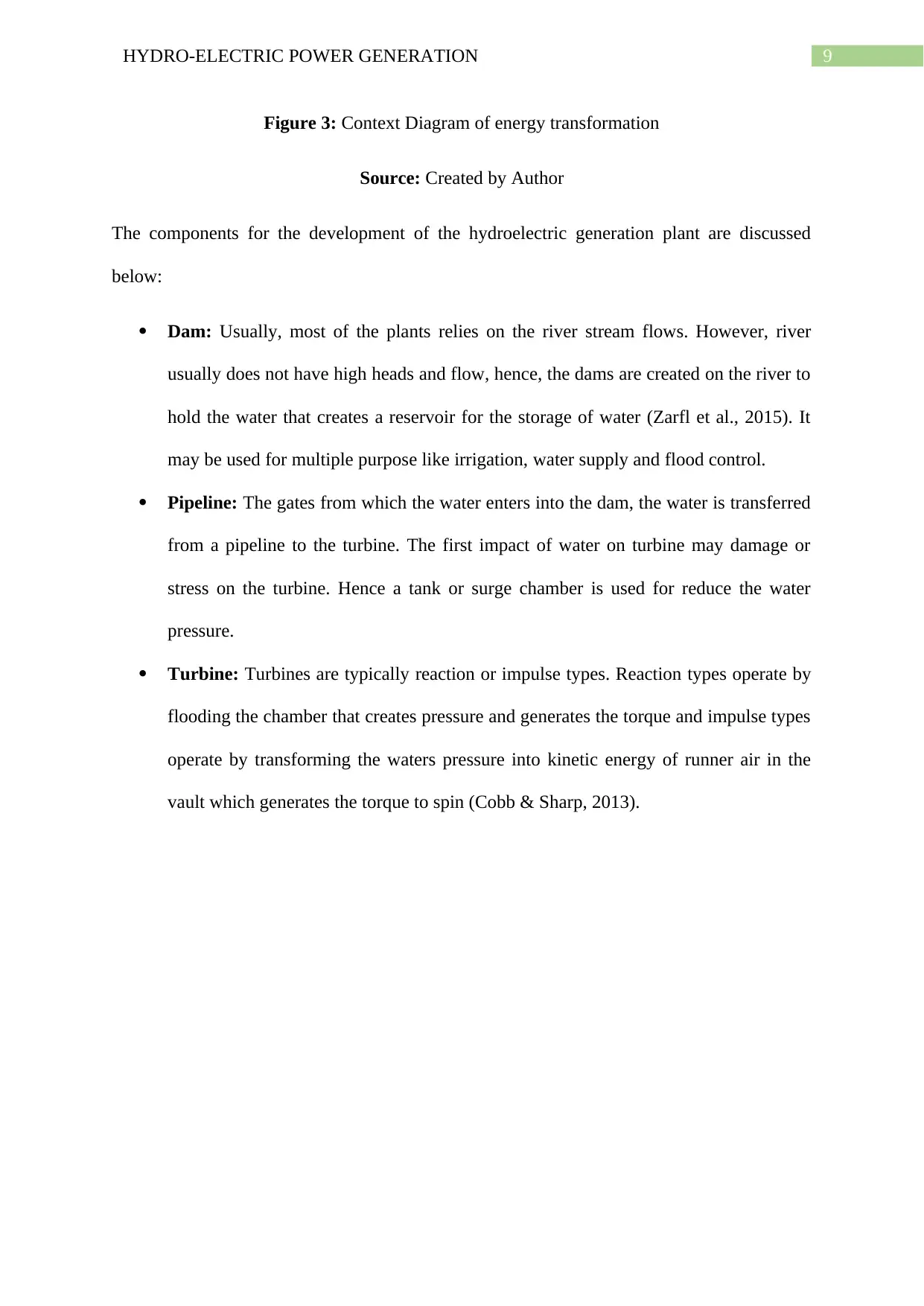
9HYDRO-ELECTRIC POWER GENERATION
Figure 3: Context Diagram of energy transformation
Source: Created by Author
The components for the development of the hydroelectric generation plant are discussed
below:
Dam: Usually, most of the plants relies on the river stream flows. However, river
usually does not have high heads and flow, hence, the dams are created on the river to
hold the water that creates a reservoir for the storage of water (Zarfl et al., 2015). It
may be used for multiple purpose like irrigation, water supply and flood control.
Pipeline: The gates from which the water enters into the dam, the water is transferred
from a pipeline to the turbine. The first impact of water on turbine may damage or
stress on the turbine. Hence a tank or surge chamber is used for reduce the water
pressure.
Turbine: Turbines are typically reaction or impulse types. Reaction types operate by
flooding the chamber that creates pressure and generates the torque and impulse types
operate by transforming the waters pressure into kinetic energy of runner air in the
vault which generates the torque to spin (Cobb & Sharp, 2013).
Figure 3: Context Diagram of energy transformation
Source: Created by Author
The components for the development of the hydroelectric generation plant are discussed
below:
Dam: Usually, most of the plants relies on the river stream flows. However, river
usually does not have high heads and flow, hence, the dams are created on the river to
hold the water that creates a reservoir for the storage of water (Zarfl et al., 2015). It
may be used for multiple purpose like irrigation, water supply and flood control.
Pipeline: The gates from which the water enters into the dam, the water is transferred
from a pipeline to the turbine. The first impact of water on turbine may damage or
stress on the turbine. Hence a tank or surge chamber is used for reduce the water
pressure.
Turbine: Turbines are typically reaction or impulse types. Reaction types operate by
flooding the chamber that creates pressure and generates the torque and impulse types
operate by transforming the waters pressure into kinetic energy of runner air in the
vault which generates the torque to spin (Cobb & Sharp, 2013).
Paraphrase This Document
Need a fresh take? Get an instant paraphrase of this document with our AI Paraphraser
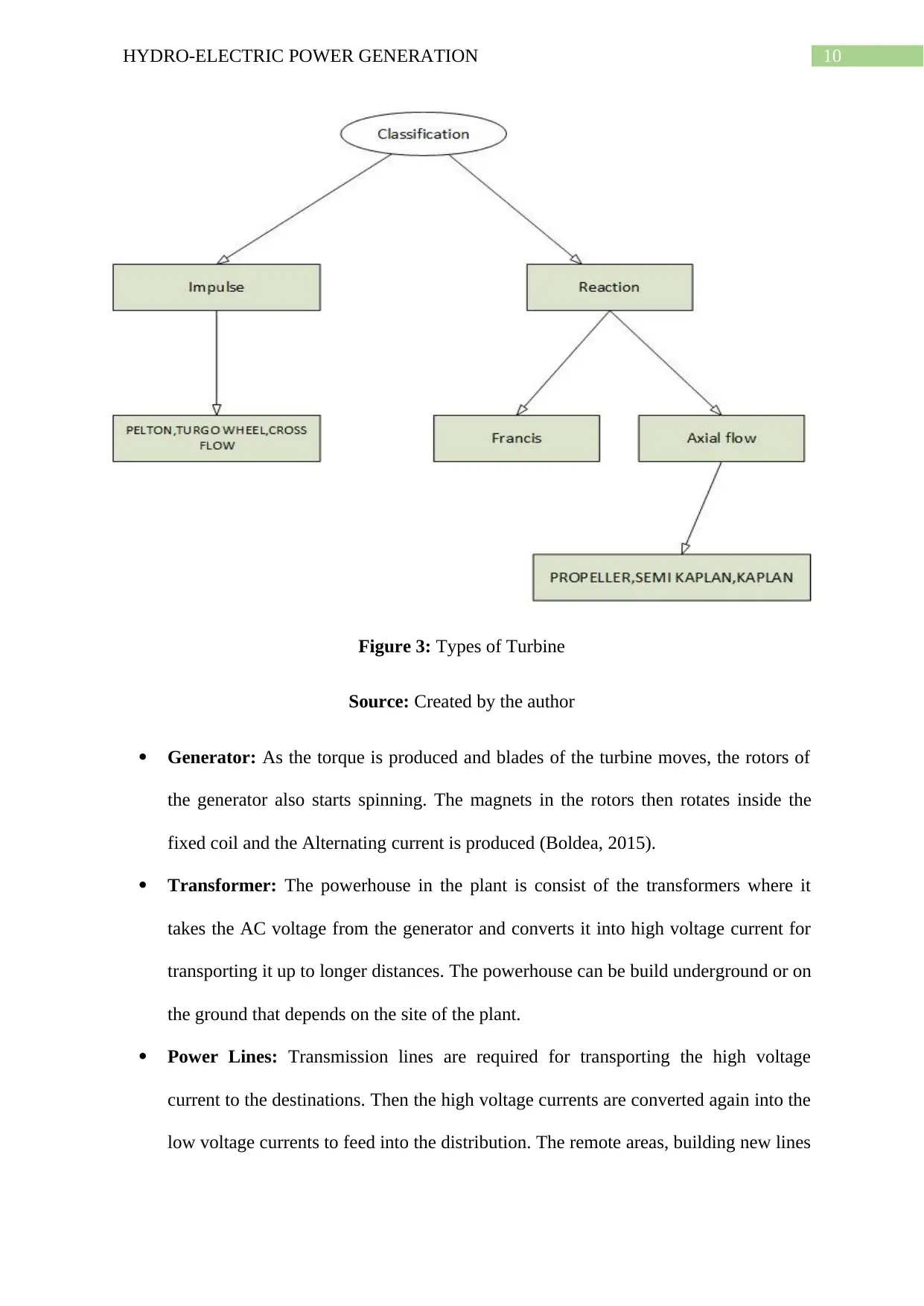
10HYDRO-ELECTRIC POWER GENERATION
Figure 3: Types of Turbine
Source: Created by the author
Generator: As the torque is produced and blades of the turbine moves, the rotors of
the generator also starts spinning. The magnets in the rotors then rotates inside the
fixed coil and the Alternating current is produced (Boldea, 2015).
Transformer: The powerhouse in the plant is consist of the transformers where it
takes the AC voltage from the generator and converts it into high voltage current for
transporting it up to longer distances. The powerhouse can be build underground or on
the ground that depends on the site of the plant.
Power Lines: Transmission lines are required for transporting the high voltage
current to the destinations. Then the high voltage currents are converted again into the
low voltage currents to feed into the distribution. The remote areas, building new lines
Figure 3: Types of Turbine
Source: Created by the author
Generator: As the torque is produced and blades of the turbine moves, the rotors of
the generator also starts spinning. The magnets in the rotors then rotates inside the
fixed coil and the Alternating current is produced (Boldea, 2015).
Transformer: The powerhouse in the plant is consist of the transformers where it
takes the AC voltage from the generator and converts it into high voltage current for
transporting it up to longer distances. The powerhouse can be build underground or on
the ground that depends on the site of the plant.
Power Lines: Transmission lines are required for transporting the high voltage
current to the destinations. Then the high voltage currents are converted again into the
low voltage currents to feed into the distribution. The remote areas, building new lines
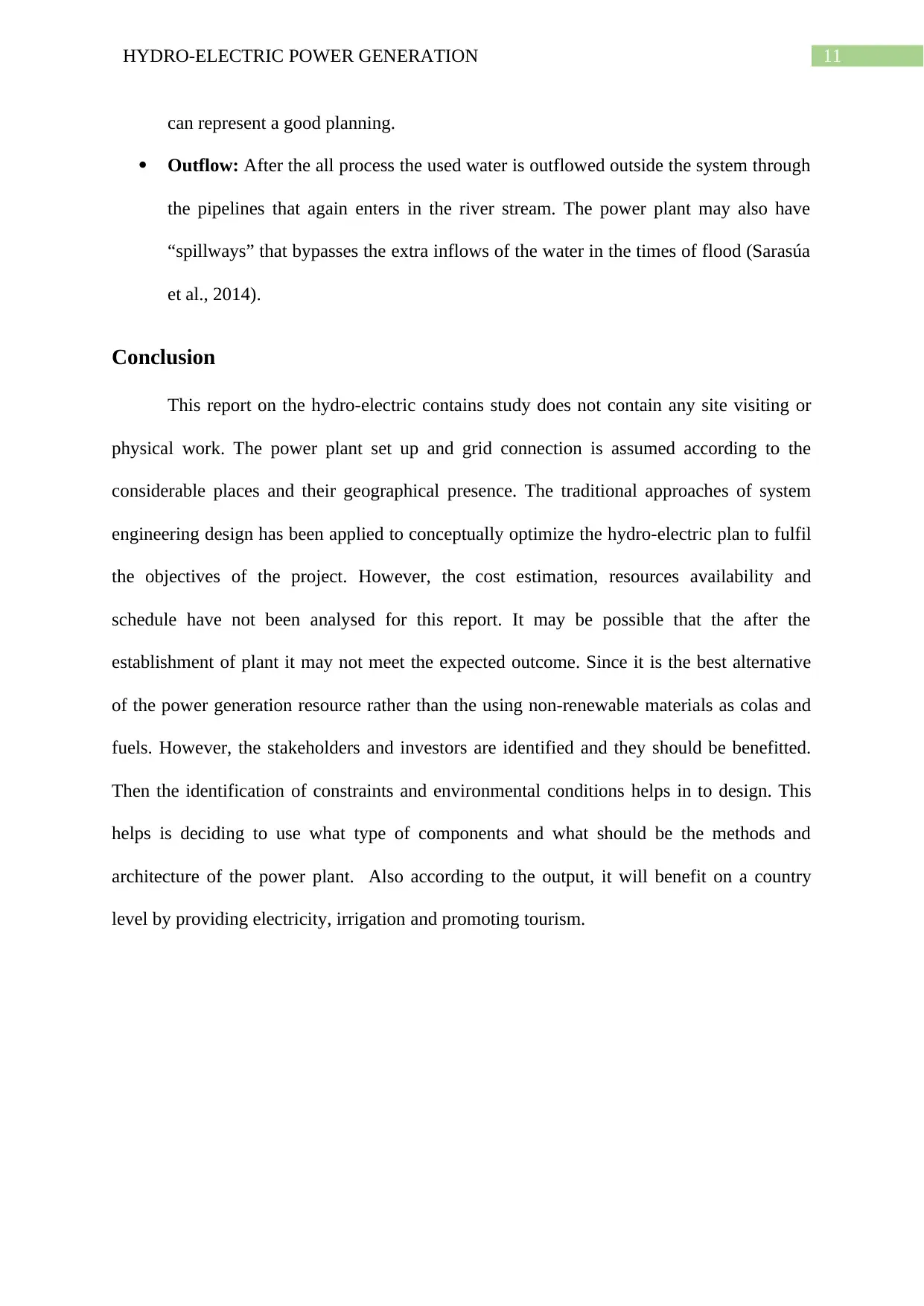
11HYDRO-ELECTRIC POWER GENERATION
can represent a good planning.
Outflow: After the all process the used water is outflowed outside the system through
the pipelines that again enters in the river stream. The power plant may also have
“spillways” that bypasses the extra inflows of the water in the times of flood (Sarasúa
et al., 2014).
Conclusion
This report on the hydro-electric contains study does not contain any site visiting or
physical work. The power plant set up and grid connection is assumed according to the
considerable places and their geographical presence. The traditional approaches of system
engineering design has been applied to conceptually optimize the hydro-electric plan to fulfil
the objectives of the project. However, the cost estimation, resources availability and
schedule have not been analysed for this report. It may be possible that the after the
establishment of plant it may not meet the expected outcome. Since it is the best alternative
of the power generation resource rather than the using non-renewable materials as colas and
fuels. However, the stakeholders and investors are identified and they should be benefitted.
Then the identification of constraints and environmental conditions helps in to design. This
helps is deciding to use what type of components and what should be the methods and
architecture of the power plant. Also according to the output, it will benefit on a country
level by providing electricity, irrigation and promoting tourism.
can represent a good planning.
Outflow: After the all process the used water is outflowed outside the system through
the pipelines that again enters in the river stream. The power plant may also have
“spillways” that bypasses the extra inflows of the water in the times of flood (Sarasúa
et al., 2014).
Conclusion
This report on the hydro-electric contains study does not contain any site visiting or
physical work. The power plant set up and grid connection is assumed according to the
considerable places and their geographical presence. The traditional approaches of system
engineering design has been applied to conceptually optimize the hydro-electric plan to fulfil
the objectives of the project. However, the cost estimation, resources availability and
schedule have not been analysed for this report. It may be possible that the after the
establishment of plant it may not meet the expected outcome. Since it is the best alternative
of the power generation resource rather than the using non-renewable materials as colas and
fuels. However, the stakeholders and investors are identified and they should be benefitted.
Then the identification of constraints and environmental conditions helps in to design. This
helps is deciding to use what type of components and what should be the methods and
architecture of the power plant. Also according to the output, it will benefit on a country
level by providing electricity, irrigation and promoting tourism.
⊘ This is a preview!⊘
Do you want full access?
Subscribe today to unlock all pages.

Trusted by 1+ million students worldwide
1 out of 15
Related Documents
Your All-in-One AI-Powered Toolkit for Academic Success.
+13062052269
info@desklib.com
Available 24*7 on WhatsApp / Email
![[object Object]](/_next/static/media/star-bottom.7253800d.svg)
Unlock your academic potential
Copyright © 2020–2025 A2Z Services. All Rights Reserved. Developed and managed by ZUCOL.





